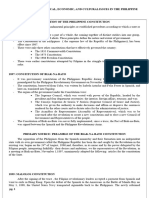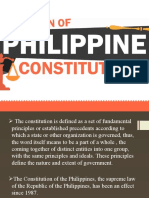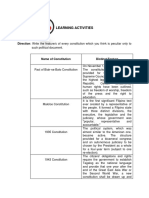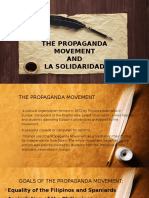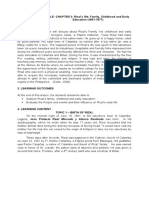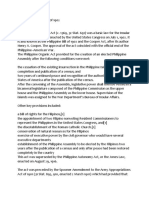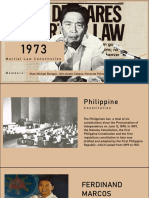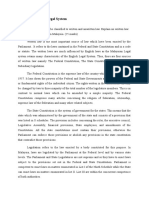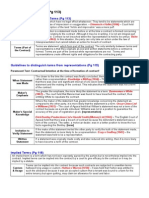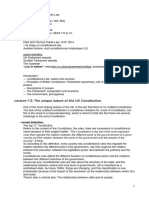0 ratings0% found this document useful (0 votes)
520 views1899
1899
Uploaded by
Bialen Alayon Julie AnnThe document summarizes key aspects of the 1899 Malolos Constitution, the first constitution of the First Philippine Republic. It was drafted after the Philippine Declaration of Independence from Spain in 1898. The constitution was modeled after other countries' constitutions and prior Philippine constitutional projects. It established a popular, representative, and responsible form of government with separate legislative, executive, and judicial powers. The legislative power was vested in a unicameral Assembly of Representatives. Executive power was vested in a president elected by a constituent assembly. However, the 1899 Malolos Constitution was never enforced due to the ongoing Philippine-American War and U.S. control over the Philippines after the 1898 Treaty of Paris.
Copyright:
© All Rights Reserved
Available Formats
Download as DOCX, PDF, TXT or read online from Scribd
1899
1899
Uploaded by
Bialen Alayon Julie Ann0 ratings0% found this document useful (0 votes)
520 views3 pagesThe document summarizes key aspects of the 1899 Malolos Constitution, the first constitution of the First Philippine Republic. It was drafted after the Philippine Declaration of Independence from Spain in 1898. The constitution was modeled after other countries' constitutions and prior Philippine constitutional projects. It established a popular, representative, and responsible form of government with separate legislative, executive, and judicial powers. The legislative power was vested in a unicameral Assembly of Representatives. Executive power was vested in a president elected by a constituent assembly. However, the 1899 Malolos Constitution was never enforced due to the ongoing Philippine-American War and U.S. control over the Philippines after the 1898 Treaty of Paris.
Original Description:
all about constitution
Copyright
© © All Rights Reserved
Available Formats
DOCX, PDF, TXT or read online from Scribd
Share this document
Did you find this document useful?
Is this content inappropriate?
The document summarizes key aspects of the 1899 Malolos Constitution, the first constitution of the First Philippine Republic. It was drafted after the Philippine Declaration of Independence from Spain in 1898. The constitution was modeled after other countries' constitutions and prior Philippine constitutional projects. It established a popular, representative, and responsible form of government with separate legislative, executive, and judicial powers. The legislative power was vested in a unicameral Assembly of Representatives. Executive power was vested in a president elected by a constituent assembly. However, the 1899 Malolos Constitution was never enforced due to the ongoing Philippine-American War and U.S. control over the Philippines after the 1898 Treaty of Paris.
Copyright:
© All Rights Reserved
Available Formats
Download as DOCX, PDF, TXT or read online from Scribd
Download as docx, pdf, or txt
0 ratings0% found this document useful (0 votes)
520 views3 pages1899
1899
Uploaded by
Bialen Alayon Julie AnnThe document summarizes key aspects of the 1899 Malolos Constitution, the first constitution of the First Philippine Republic. It was drafted after the Philippine Declaration of Independence from Spain in 1898. The constitution was modeled after other countries' constitutions and prior Philippine constitutional projects. It established a popular, representative, and responsible form of government with separate legislative, executive, and judicial powers. The legislative power was vested in a unicameral Assembly of Representatives. Executive power was vested in a president elected by a constituent assembly. However, the 1899 Malolos Constitution was never enforced due to the ongoing Philippine-American War and U.S. control over the Philippines after the 1898 Treaty of Paris.
Copyright:
© All Rights Reserved
Available Formats
Download as DOCX, PDF, TXT or read online from Scribd
Download as docx, pdf, or txt
You are on page 1of 3
Republic of the Philippines
CAPIZ STATE UNIVERSITY
Main Campus, Roxas City
College of Education
Julie Ann A. Bialen Prof. Jenylyn Faelangco
BPED IA Course Facilitator
1899: Malolos Constitution
After the signing of the truce, the Filipino revolutionary leaders accepted a
payment from Spain and went to exile in Hong Kong. Upon the defeat of the
Spanish to the Americans in the battle of Manila Bay on 1 May 1898, the United
States Navy transported Aguinaldo back to the Philippines. The newly reformed
Philippine revolutionary forces reverted to the control of Aguinaldo, and the
Philippine Declaration of Independence was issued on 12 June 1898, together with
several decrees that formed the First Philippine Republic. The Malolos Congres
was elected, which selected a commission to draw up a draft constitution on 17
September 1898, which was composed of wealthy and educated men.
The document they came up with, approved by the Congress on 29 January
1899, was titled “The Political Constitution of 1899” and written in Spanish. The
constitution has 39 articles divided into 14 titles, with eight articles of transitory
provisions, and a final additional article. The document was patterned after the
Spanish Constitution of 1812, within influences from the charters of Belgium,
Mexico, Brazil, Nicaragua, Costa Rica, and Guatemala, and the French constitution
of 1793. According to Felipe Calderon, main author of the constitution, these
countries were studied because they shared similar social, political, technological,
and governments conditions with the Philippines. Prior Constitutional project in
the Philippines also influenced the Malolos Constitution, namely, the Kartilya and
the Sangguniang-Hukuman, the Charter of laws and the morals of the Katipunan
written by Emilio Jacinto in 1896; the Biak-na-bato Constitution of 1897 planned
by Isabelo Artacho; Mabini’s Constitutional program of the Philippine Republic of
1898; the provisional Contitution of Mariano Ponce in 1898 the followed the
Spanish Constitution; and the autonomy project of Paterno of 1898.
Primary Source: Preamble of the Political Constitution of 1899
We, the Representatives of Filipino people, lawfully convened, in order to
established justice, provide for common defense promote the general welfare and
insure the benefits of liberty, imploring the aid of the Sovereign Legislator of the
universe for the attainment of this ends, have voted, decreed, and sanctioned the
following political constitution.
As a direct challenge to colonial authorities of the Spanish Empire, the
sovereignty was retroverted to the people, a legal principle underlying the
Philippine Revolution. The people delegated governmental functions to civil
servants while they retained actual sovereignty. The 27 article of title IV detail the
natural rights and popular sovereignty of Filipinos, the enumeration of which does
not imply the prohibition of any other right not expressly stated. Title III, Article V
also declares that the states recognizes the freedom and equality of all beliefs, as
well as the separations of church and state. These are direct reactions to features of
the Spanish government in the Philippines, where the friars were dominant agents
of the state.
The form of government, according to title II, Article 4 is to be popular,
representative, alternative, and responsible, and shall exercise three distinct power-
legislative, executive, and judicial. The legislative power was vested in a
unicameral body called the Assembly of Representatives, members of which are
elected for terms of four years. Secretaries of the government were given seats in
the assembly, which meet annually for a period of atleast three months. Bills could
be introduced either by the president or by a member of the assembly. Some
powers not legislative in nature were also given to the body, such as the right to
select its own officers, right of censure and interpellation, and the right of
impeaching the president, cabinet members, the chief justice of the supreme court,
and the solicitor-general. A permanent commission of seven, elected by the
assembly, and granted specific powers by the constitution, was to sit during the
intervals between sessions of the assembly.
Executive power was vested in the president, and elected by a constituent
assembly of the assembly of the representatives and special representatives. The
president will serve a term of four years without re-election. There was no vice-
president, and in case of a vacancy, a president was to be selected by the
Constituent Assembly.
The 1899 Malolos Constitution was never enforced due to the ongoing war.
The Philippines was effectively a territory of the United States upon the signing of
the Treaty of Paris between Spain and the United States, transferring sovereignty
of the Philippines on 10 December 1898.
You might also like
- Laguna State Polytechnic University: Course Sem/AyDocument7 pagesLaguna State Polytechnic University: Course Sem/AyShaine Cariz Montiero SalamatNo ratings yet
- The Act of The Declaration of Philippine Independence: Ambrosio Rianzares BautistaDocument19 pagesThe Act of The Declaration of Philippine Independence: Ambrosio Rianzares BautistaSam Jimenez100% (1)
- Chapter 4 Social Political Economic and Cultural Issues in Philippine HistoryDocument135 pagesChapter 4 Social Political Economic and Cultural Issues in Philippine HistoryMMC BSEDNo ratings yet
- CHAPTER 4readings in Philippine HistoryDocument10 pagesCHAPTER 4readings in Philippine HistoryeyrameciojnNo ratings yet
- Evolution of The Philippine Constitution 1Document35 pagesEvolution of The Philippine Constitution 1Jerlyn LotoNo ratings yet
- A Reading in Philippine History-Topic8Document8 pagesA Reading in Philippine History-Topic8Justine PrudenteNo ratings yet
- Background and History of Liliosa HilaoDocument3 pagesBackground and History of Liliosa HilaoReychel Luna100% (1)
- The Malolos ConstitutionDocument3 pagesThe Malolos ConstitutionTori PeigeNo ratings yet
- Filipino Grievances Against Governor Wood IDocument2 pagesFilipino Grievances Against Governor Wood IAngelyme TayoNo ratings yet
- Philippine Commonwealth FinalDocument13 pagesPhilippine Commonwealth FinalJames Patrick TorresNo ratings yet
- Nstp-Cwts Module 5Document7 pagesNstp-Cwts Module 5Harvey BareteNo ratings yet
- Cry of Balintawak 2.0Document27 pagesCry of Balintawak 2.0Lohan KeshnerNo ratings yet
- The First Philippine Republic and The Malolos ConstitutionDocument2 pagesThe First Philippine Republic and The Malolos Constitutionjucsxxx67% (3)
- 1935 ConstitutionDocument25 pages1935 ConstitutionJustine BayhonNo ratings yet
- GED 2 Module 2Document5 pagesGED 2 Module 2Cj Nicole SURIAGANo ratings yet
- THE FILIPINO MIND - President Elpidio Quirino and The Cult of Power - Suppressing The Hardie Report PDFDocument10 pagesTHE FILIPINO MIND - President Elpidio Quirino and The Cult of Power - Suppressing The Hardie Report PDFBert M DronaNo ratings yet
- The Constitution of The Philippine CommonwealthDocument3 pagesThe Constitution of The Philippine Commonwealtheydel_beeNo ratings yet
- BSHM 1-4 - Group 5 - KartillaDocument25 pagesBSHM 1-4 - Group 5 - KartillaKatricia Elaine VillanuevaNo ratings yet
- Rizal Lesson 9Document34 pagesRizal Lesson 9Cristian MitraNo ratings yet
- Malolos ConstitutionDocument2 pagesMalolos ConstitutionLoren ArceNo ratings yet
- Act of Declaration of IndependenceDocument67 pagesAct of Declaration of IndependenceGerard Byron Jacildo100% (1)
- History of How NSTP WAS Created: GroupDocument8 pagesHistory of How NSTP WAS Created: GroupChing DialomaNo ratings yet
- Alfred McCoy Political Caricatures of The American EraDocument33 pagesAlfred McCoy Political Caricatures of The American EraSerg's Bihag IVNo ratings yet
- Commission On Indepence Filipino Grievances Against GovernorDocument21 pagesCommission On Indepence Filipino Grievances Against GovernorAira Mae MambagNo ratings yet
- UNIT Topic 2 Lesson 9 10 CORY AQUINOS Speech Before The U.S. CongressDocument5 pagesUNIT Topic 2 Lesson 9 10 CORY AQUINOS Speech Before The U.S. CongressJunko CaytonNo ratings yet
- GE 2 - Readings in THE Philippine History Midterm Exam: 1 SEMESTER SY: 2020-2021Document5 pagesGE 2 - Readings in THE Philippine History Midterm Exam: 1 SEMESTER SY: 2020-2021Emmanz CaballeroNo ratings yet
- Speech of President Corazon Aquino During The Joint Session of The U.S. Congress, September 18, 1986Document7 pagesSpeech of President Corazon Aquino During The Joint Session of The U.S. Congress, September 18, 1986Rondina, Elvie Rose P.No ratings yet
- Evolution of The Philippine ConstitutionDocument47 pagesEvolution of The Philippine ConstitutionJaylen delRosarioNo ratings yet
- Manuel L. QuezonDocument10 pagesManuel L. QuezonRaymond LomerioNo ratings yet
- Phil History Lesson 7Document19 pagesPhil History Lesson 7Cherry castellonNo ratings yet
- Midterm - RPH .WPS OfficeDocument15 pagesMidterm - RPH .WPS OfficeBernadeth P. LapadaNo ratings yet
- Instability ofDocument2 pagesInstability ofJean Rema GonjoranNo ratings yet
- Background of The AuthorDocument5 pagesBackground of The AuthorRodrinerBillonesNo ratings yet
- The Malolos ConstitutionDocument9 pagesThe Malolos ConstitutionErica BorbonNo ratings yet
- Module 1 Science Technology and SocietyDocument12 pagesModule 1 Science Technology and SocietyFatima NatividadNo ratings yet
- Readings in Philippine History Chapter 10 - PUGAD LAWIN, BALINTAWAK, OR TORODocument29 pagesReadings in Philippine History Chapter 10 - PUGAD LAWIN, BALINTAWAK, OR TOROJHON MICCO ERGINANo ratings yet
- The Propaganda Movement AND La Solidaridad: Group 6Document14 pagesThe Propaganda Movement AND La Solidaridad: Group 6Mechelle jean CurayNo ratings yet
- Role of Women in The Period of RevolutionDocument4 pagesRole of Women in The Period of RevolutionRc RcNo ratings yet
- CHAPTER 3. Rizal's Life - Family, Childhood and Early Education (1861-1877)Document12 pagesCHAPTER 3. Rizal's Life - Family, Childhood and Early Education (1861-1877)Erick LabradorNo ratings yet
- Rise of Filipino NationalismDocument68 pagesRise of Filipino NationalismDANIELLA JOIZ MARI DIAZNo ratings yet
- Readings in Philippine History: Kartilya NG KatipunanDocument4 pagesReadings in Philippine History: Kartilya NG KatipunanNiña Rica PunzalanNo ratings yet
- The Battle of Tirad PassDocument8 pagesThe Battle of Tirad PassArianne Pangilinan100% (1)
- Aquino's Speech To The US CongressDocument2 pagesAquino's Speech To The US CongressCharm LucasNo ratings yet
- Filipino Grievances Against: Governor WoodDocument39 pagesFilipino Grievances Against: Governor WoodEllaine TorrelizaNo ratings yet
- Philippine Organic Act of 1902Document5 pagesPhilippine Organic Act of 1902Lizza AlipioNo ratings yet
- The Constitution of The Philippine CommonwealthDocument11 pagesThe Constitution of The Philippine CommonwealthBJ AmbatNo ratings yet
- Analysis of Cory AquinoDocument1 pageAnalysis of Cory AquinoDos por dosNo ratings yet
- Who Are The Citizens of The PhilippinesDocument1 pageWho Are The Citizens of The PhilippinesLaurel White100% (1)
- Kartilya NG KatipunanDocument5 pagesKartilya NG KatipunanNorlyn Joy InsigneNo ratings yet
- RPH Amorsolo and Luna PaintingDocument36 pagesRPH Amorsolo and Luna PaintingRichelle LozanoNo ratings yet
- Ninoy Aquino Speech Reaction PaperDocument1 pageNinoy Aquino Speech Reaction Paperjohnny100% (1)
- Readings in Philippine HistoryDocument32 pagesReadings in Philippine HistoryAileen MalanaNo ratings yet
- Andres Bonifacio and The KatipunanDocument2 pagesAndres Bonifacio and The KatipunanPatrick BacongalloNo ratings yet
- Speech of CoryDocument6 pagesSpeech of CoryKenchi CasanaresNo ratings yet
- Group 2 Evolution of Philippine ConstitutionDocument23 pagesGroup 2 Evolution of Philippine ConstitutionZion WilliamsonNo ratings yet
- The Propaganda Movement and The KatipunanDocument9 pagesThe Propaganda Movement and The Katipunanarteezy artour100% (3)
- 1973 Martial Law ConstitutionDocument13 pages1973 Martial Law ConstitutionIka PinkNo ratings yet
- RIPH MidtermDocument5 pagesRIPH MidtermMatelyn Oarga100% (1)
- Evolution of The Taxation in The Philippines Post War Marcos Aquino Ramos AdministrationDocument4 pagesEvolution of The Taxation in The Philippines Post War Marcos Aquino Ramos AdministrationSairah Camille ArandiaNo ratings yet
- Araneta Vs DinglasanDocument2 pagesAraneta Vs DinglasanJolo Coronel100% (1)
- CBSE Class 8 Civics Worksheet - The Indian ConstitutionDocument10 pagesCBSE Class 8 Civics Worksheet - The Indian ConstitutionAkshayaNo ratings yet
- Succsession Certificate and ProbateDocument13 pagesSuccsession Certificate and Probatemantravakil2709No ratings yet
- Feliciano vs. COA PDFDocument2 pagesFeliciano vs. COA PDFCrizNo ratings yet
- House Bill 15-1161Document5 pagesHouse Bill 15-1161Michael_Lee_RobertsNo ratings yet
- Writ Suresh Chand and OthersDocument18 pagesWrit Suresh Chand and Othersujjwal pratapsinghNo ratings yet
- Ah Thian V Government of MalaysiaDocument7 pagesAh Thian V Government of MalaysiaRobin WongNo ratings yet
- Wills, Trusts, and Estates NotesDocument90 pagesWills, Trusts, and Estates NotesTara ShaghafiNo ratings yet
- Indian Stamp (Haryana Amendment) Act, 2018 PDFDocument4 pagesIndian Stamp (Haryana Amendment) Act, 2018 PDFsandeep kumarNo ratings yet
- Lesson 8article 5 of Ra 8495Document11 pagesLesson 8article 5 of Ra 8495test 2No ratings yet
- in Re Alvarado v. Gaviola, JR., G.R. No. 74695, (September 14, 1993) )Document7 pagesin Re Alvarado v. Gaviola, JR., G.R. No. 74695, (September 14, 1993) )yasuren2No ratings yet
- Affidavit of DiscrepancyDocument5 pagesAffidavit of DiscrepancyKenneth GarciaNo ratings yet
- Syllabus WillsDocument6 pagesSyllabus WillsChristopher Jan DotimasNo ratings yet
- Sri Sankari Prasad Singh Deo Vs Union of India and State of BiharDocument19 pagesSri Sankari Prasad Singh Deo Vs Union of India and State of BiharRohit KumarNo ratings yet
- Topic 1 - Malaysian Legal SystemDocument2 pagesTopic 1 - Malaysian Legal SystemAhmad MuzNo ratings yet
- 12th Case - Ajero Vs CA - DigestDocument1 page12th Case - Ajero Vs CA - DigestPaolo PacquiaoNo ratings yet
- Separation of PowerDocument25 pagesSeparation of PowerKuber JaishiNo ratings yet
- 3 Contract - Terms and Exclusion ClausesDocument5 pages3 Contract - Terms and Exclusion ClausesglenlcyNo ratings yet
- BilltzDocument3 pagesBilltzspom.mmariNo ratings yet
- In Re Atty Marcial Edilion A M 1928 August 3 1978Document2 pagesIn Re Atty Marcial Edilion A M 1928 August 3 1978Bernard CuerdoNo ratings yet
- (Applause (Signs The Document) : I Will Now Read The Dispositive Portion of This DecreeDocument1 page(Applause (Signs The Document) : I Will Now Read The Dispositive Portion of This DecreeAvi AlonzoNo ratings yet
- UK Public LawDocument88 pagesUK Public Lawjmn.elmNo ratings yet
- Mss Sp-55 Inspeccion Visual de FundicionDocument40 pagesMss Sp-55 Inspeccion Visual de FundicionArmando Lujan VelazquezNo ratings yet
- Main Features of The Constitution of ArgentinaDocument2 pagesMain Features of The Constitution of ArgentinaPamela Andrea100% (1)
- Syllabus in SuccessionDocument8 pagesSyllabus in SuccessionrpalmesbioNo ratings yet
- Lpu Im Petition For Unconstitutionality Ra 11659Document30 pagesLpu Im Petition For Unconstitutionality Ra 11659JadeiteNo ratings yet
- Unit 1 NotesDocument14 pagesUnit 1 Notessarathkumar sebastinNo ratings yet
- Introduction To Italian LawDocument106 pagesIntroduction To Italian LawzeranoplaysNo ratings yet
- CentralBank Versus BSP - GR.148208 - DigestDocument2 pagesCentralBank Versus BSP - GR.148208 - Digestbline seguradaNo ratings yet
- Isr 3 Declaration For Opting Out of NominationDocument1 pageIsr 3 Declaration For Opting Out of NominationGiwoNo ratings yet



